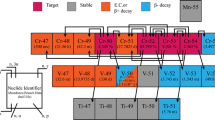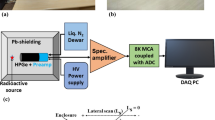Abstract
We present and evaluate a program for the semi-empirical calculation of the full-energy peak efficiency of a hyper-pure germanium detector, by using the efficiency transfer method. Using simple Monte-Carlo integration and constructive solid geometry, we are able to calculate the effective solid angle for a wide range of HPGe detector and sample geometries. However, the main advancement is including in our calculations the inhomogeneity of the sample activity, caused by the inhomogeneous neutron flux when performing neutron activation analysis (NAA). This reduces systematic error in the standard procedure of NAA. To increase usability, the input and output file formats used are compatible with the program SOLANG, which belongs to the Kayzero for Windows (KayWin®) software.








Similar content being viewed by others
References
Moens L, De Donder J, Lin X, De Corte F, De Wispelaere A, Simonits A, Hoste J (1981) Calculation of the absolute peak efficiency of gamma-ray detectors for different counting geometries. Nucl Instrum Methods 187:451–472
Jovanovic S, Dlabac A, Mihaljevic N (2010) ANGLE v2.1—New version of the computer code for semiconductor detector gamma-efficiency calculations. Nucl Instrum Methods Phys Res A 622:385–391
Vidmar T, Celik N, Cornejo Diaz N, Dlabac A, Ewa IOB, Carrazana González JA, Hult M, Jovanovic S, Lepy MC, Mihaljevic N, Sima O, Tzika F, Jurado Vargas M, Vasilopoulou T, Vidmar G (2010) Testing efficiency transfer codes for equivalence. Appl Radiat Isot 68:355–359
Jaćimović R (2015) Validation of the standard procedure of the k 0-INAA using soil and sediment reference materials, 14th international conference on modern trends in activation analysis, Delft, August 23–28, 2015, 11th international conference on nuclear analytical methods in life sciences, Delft, August 23–28, 2015. Program and abstracts. Reactor Institute Delft, 2015
Jaćimović R, Stibilj V, Benedik L, Smodiš B (2003) Characterization of the neutron flux gradients in typical irradiation channels of a TRIGA Mark II reactor. J Radioanal Nucl Chem 257:545–549
De Corte F (1987) The k 0-standardization method: a move to the optimization of neutron activation analysis (habilitation thesis). State University of Ghent, Ghent, Belgium
Moens L, De Corte F, Simonits A, Xilei L, De Wispelaere A, De Donder J, Hoste J (1982) Calculation of the absolute peak efficiency of Ge and Ge(Li) detectors for different counting geometries. J Radioanal Chem 70:539–550
Kayzero for Windows (KayWin®) User’s Manual, for reactor neutron activation analysis (NAA) using the k 0-standardization method, ver. 2.42 (2011)
Menezes MABC, Jaćimović R, Pereira C (2015) Spatial distribution of neutron flux in geological larger sample analysis at CDTN/CNEN, Brazil. J Radioanal Nucl Chem 306:611–616
Jiang SH, Liang JH, Chou JT, Lin UT, Yeh WW (1998) A hybrid method for calculating absolute peak efficiency of germanium detectors. Nucl Instrum Methods Phys Res A 413:281–292
Jaćimović R (2008) Absolute calibration of an HPGe detector using KayWin software, JSI work report IJS-DP-9885. Jožef Stefan Institute, Ljubljana, Slovenia
Advanced Micro Devices (January 2013) BIOS and Kernel Developer’s Guide (BKGD) for AMD Family 15 h Models 00h–0Fh Processors, 42301 Rev 3.14
Bučar T (2008) Evaluation of overall measurement uncertainty using the k 0-based neutron activation analysis (doctoral dissertation). Jožef Stefan International Postgraduate School, Ljubljana, Slovenia
Acknowledgements
The work was performed in the scope of program group P1-0143 at the Jožef Stefan Institute, within the project PR-06174, financed by the Slovenian Research Agency.
Author information
Authors and Affiliations
Corresponding author
Rights and permissions
About this article
Cite this article
Gačnik, L., Jaćimović, R. HPGe detector full-energy peak efficiency calculation for inhomogeneously activated samples. J Radioanal Nucl Chem 311, 1315–1321 (2017). https://doi.org/10.1007/s10967-016-5130-9
Received:
Published:
Issue Date:
DOI: https://doi.org/10.1007/s10967-016-5130-9




